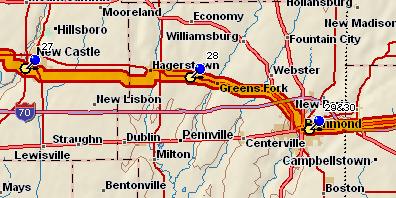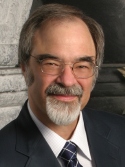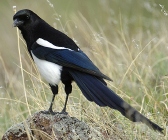In Company to Richmond
On the morning of July 27, I joined my new traveling companion, Charlotte, and the pastor of Cadiz Friends Church, at the latter’s home for breakfast. My feet were still not recovered from their turn to the worse; so after breakfast, it was decided that Charlotte and the pastor would walk the day’s route in my stead, while I tagged along, shadowing them in my car and hobbling bits of the route as my feet permitted.
It was now Charlotte’s turn to be hard-hit by encounters with all the road kill along the highway. (Dear Friends, the extent of roadkill carnage is not to be taken lightly; it is a significant environmental impact in this country!) But the route was otherwise lovely, as we worked our way deeper into the countryside, away from Indianapolis.
That evening we were hosted in New Castle by New Castle First Friends, which had already met with me in conjunction with Cadiz Friends the previous night. I was given a place to stay with a couple in the process of adopting a very lovable dog; Charlotte stayed with a Friend who had walked from her home to Washington, D.C., as a witness for peace last year.
 From New Castle to Richmond is a distance of about thirty miles, with no convenient place to stay in the middle. When I had thought I would be walking that distance alone, without benefit of pack, I had planned to try to walk about two-thirds of the distance the first day, a very long day’s hike, so as to reach a motel; once Charlotte began talking about walking with me, I began thinking instead in terms of finding a farmer who would allow us to camp on his land half-way. Now that I was half-crippled and availing myself of a car, these logistical problems were no longer such an obstacle; Charlotte and I agreed to cover half the distance each day and simply use the car to get to lodging in the intervening night.
From New Castle to Richmond is a distance of about thirty miles, with no convenient place to stay in the middle. When I had thought I would be walking that distance alone, without benefit of pack, I had planned to try to walk about two-thirds of the distance the first day, a very long day’s hike, so as to reach a motel; once Charlotte began talking about walking with me, I began thinking instead in terms of finding a farmer who would allow us to camp on his land half-way. Now that I was half-crippled and availing myself of a car, these logistical problems were no longer such an obstacle; Charlotte and I agreed to cover half the distance each day and simply use the car to get to lodging in the intervening night.
The first day out from New Castle was as glorious a walk as one could hope for — comfortable weather, reasonably quiet roads, a fair percentage of back roads, some winding sections with scenic curves and hills. I was only able to walk about two miles of it, but I found that a pattern of parking at one-mile intervals and keeping half an eye on Charlotte’s walking for safety’s sake, was very conducive to listening to the land wherever I was parked, and not too poor a substitute for walking myself. And it was pleasant to have someone to compare notes with every half-hour or so, as Charlotte caught up with me and passed me on the road.
Toward late afternoon, as we were completing the final leg of the day’s walk, a very substantial thunderstorm boiled up in the skies overhead. We could see the clouds roiling and growing, and the veils of rain forming in the distance and marching across the land, as the winds picked up and tore at the trees around us. Soon we could pick out one area of rain upwind of us that seemed destined to overtake us — and I was fascinated by the way our connectedness with the landscape around us seemed to deepen as our concern about that approaching rain intensified! A violent storm such as this creates dynamics and motions that pull the world around an observer into a visibly interconnected whole —
We completed the day’s walk just seconds before the rain front arrived and began pelting us in earnest. And I later heard that this storm brought as much as four inches of rain to areas just south of us, and caused some significant flooding.
After a night spent in a motel a bit off the direct route of our walk, we resumed the journey the next morning. Once again, I could only walk about two miles, and was reduced to sitting and listening the rest of the way. Charlotte experienced some powerful openings linking the situation of the corn plants in the fields we were passing through, to the situation of the children she teaches in the Chicago school system. My own openings were more modest, but clearly part of the continuing growth in understanding that I have been talking about from time to time in this blog site; I will report on them here when they have ripened further in my heart and mind.
Traffic picked up considerably as we approached the city of Richmond, Indiana, and the road became hazardous enough that we agreed it was wiser simply to drive the final mile across the Interstate and into town.
The pastor of Richmond First Friends had arranged for us to stay in Richmond at the Quaker Hill Conference Center, a simple-but-lovely facility with a wonderfully still, grounded, prayerful atmosphere. We had a bite to eat with our pastor, and I prepared myself as best I could in heart and spirit for the round of meetings I had scheduled for the following day.





Reader Comments (6)
-- comment posted by Alan Palmer
July 2nd, 2006 at 8:42 p.m.
Basically, the idea is that the smaller the area of habitat, the fewer animals of a given species it can support. Since the ability of a species’ population to withstand and overcome setbacks such as bad years or heavy predation declines as its numbers declines, when a given area of habitat is reduced in size, that area loses the ability to support as many species for more than a few generations.
Thus, cutting an area of habitat into two separate areas, by means of a road that some or all species cannot cross without being killed by traffic, works to reduce the number of species it can support over long periods of time. This is indeed a significant environmental impact.
For more information, you might want to take a look at books such as Robert H. MacArthur and Edward O. Wilson, *The Theory of Island Biogeography*; Larry D. Harris, *The Fragmented Forest: Island Biogeography Theory and the Preservation of Biotic Diversity*; Michael E. Soulé, ed., *Viable Populations for Conservation*; etc.
-- comment posted by Marshall
July 5th, 2006 at 10:15 a.m.
Marshall, I hope it does not hurt you too badly to be told that you did what the Congress and the present Administration in Washington do: You changed the conversation! Lord, help us, you are not a Republican, are you? This is about whether there is good evidence that animal vehicular homocide (Wait, if it’s an animal it isn’t HOMOcide, is it?) or suicide has a significant enviromental impact as you have said. I think not.
Nonetheless, I went to the nearby university library and checked out the three books you recommended. I fear I accepted a wild goose chase. A snipe hunt. (Apt animal analogies, eh?) There is nothing in their tables of content or indices to indicate anything at all about roadkill, by that name or any other. Regardless, I will peruse their pages for said evidence to see if I must return to this site with hat in hand to eat humble pie or crow, to wildly mix my metaphors and also admit another named animal, or if what you have said is pretentious, effete, self-absorbed, pedantic, intellectual, hyperbolic, emotional, anecdotal rhetoric —- to be kind and also to mention yet another animal, bovine dung. Peace, Brother and Friend, Alan
-- comment posted by Alan Palmer
July 5th, 2006 at 4:26 p.m.
BrotheR
Sorry ’bout that.
-- comment post by Alan Palmer
July 5th, 2006 at 4:36 p.m.
I think one would not expect a book on physics to list, in the index at the back of the book, *every single item* that can fall at 32 feet per second per second here on good ol’ Planet Earth. And similarly, one would not expect a book on island biogeography theory to list, in the index at the back of the book, every single factor that can divide the animal population of one area of habitat from the animal population of another.
It is enough, in exploring the theory of gravitation, to know that all objects possessing nonzero mass fall at the same speed in a vacuum — so that, if one knows that something is an object of nonzero mass, one can predict it will fall at that speed.
And it is similarly enough, in exploring the theory of island biogeography, to know that all factors that prevent creatures from crossing from one area of habitat to the next, have the same deleterious impact on population dynamics — so that, if one knows that some factor, such as death due to highway collision, prevents creatures from crossing from one area to the next, one can predict it will have such an impact, and even work up a mathematical model to better examine the impact it will have. That’s what MacArthur’s equations are about.
I might add that a high rate of deaths due to vehicular traffic can also pose *direct* threats to species, as e.g. with tortoises in the Mojave Desert. But that is a less general problem.
As for the rest of your posting, there is really no place for that sort of belittling and abusive language in Quaker speech or on a Quaker blog site. We are called to model God’s love to the world. There are better ways of expressing criticism, and I must ask that you limit yourself to them.
-- comment posted by Marshall
July 7th, 2006 at 1:58 p.m.
-- comment posted by Alan Palmer
July 13th, 2006 at 3:12 p.m.